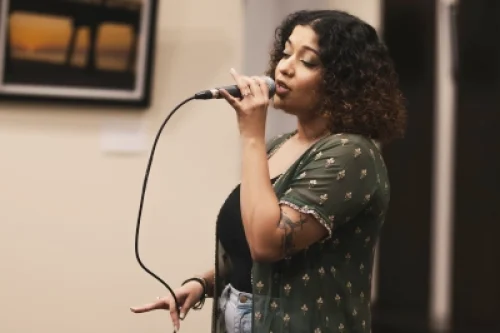Create Great Instrumental Tracks when you aren’t an instrumentalist
When I am working with singers on their songwriting projects, I tend to hear the same excuse from every single one of them… “I don’t have a band and I can’t play all the instruments”!
This is a frustration I can deeply relate to, as I only play piano enough to write songs but not enough to perform them. I certainly don’t have skills on the guitar or drums either, but I can demonstrate what I can hear in my head. Utilizing the resources you have available can help create the best backing tracks for your songs. I hope you find this helpful!
Get the best demo made that you can create
No matter how awkward it may sound, do your best to create what you hear in your head. For me this meant playing chords on the piano and singing vocal percussion to get my idea across. It was not a polished demo or anything I would be distributing but it conveyed the groove of the song and the structure of the song.
Create some sort of chordal track to showcase the song and sing scratch vocals over top of it. Once you have that in place, you can use several methods to add extra instruments. The addition of percussion, loops, bass, horns, background vocals, etc. can add to the fullness of a song. I list some options below if you aren’t sure where to begin.
Once you have some sort of demo recorded, you have something to share with others. Which is much better than awkwardly trying to explain the abstract idea of your song to other musicians. You can then begin to plan for the actual recording session!
Use the software that is available to you (Garageband, Logic Pro, Ableton, etc)
There are many different brands of music production software available, ranging in price from free to hundreds of dollars. See what you are comfortable with and learn the basics of recording and creating “loops” or beats. For many artists, the ability to create a backing track is simple with these tools.
Get creative with making adjustments to the timing and shifting instrument sounds. Your backing track will sound truly original with these adjustments. You don’t need to understand programming new beats or new midi sounds.
Many of my students use Garageband to start with since iphones and ipads include the software for free. I recommend watching a youtube tutorial and diving in!
Find a producer to create beats for you
Yes I realize this will cost some money potentially, but it is worth paying for! There are so many creative producers out there who enjoy making beats and loops and you can collaborate with them.
Several of my clients have developed working relationships with producers who will create customized backing tracks for their original music. As a singer, you can show similar sounds and artists you like and then show your rough demo to someone and let them use their creativity to design backing tracks.
Make sure you discuss how you will split the songwriting rights when you work together. Put it in writing so you are treating each composition collaboration as a professional would!
Collaborate with instrumentalists
You wrote this great melody and you like your lyrics, but you just can’t figure out a good bass groove or guitar riff? Hire an instrumentalist who you love working with!
We are not meant to play all the instruments and also sing with prolific ability! If you can’t play drums, why would you expect yourself to create a killing drum groove? Hire a drummer! They can help program electronic drums or can play the drums for you. This goes for any instrument.
I knew what I wanted as far as chords and basic melodic movement in the piano part, but I didn’t have the chops to pull it off for recording. I met with a studio pianist and we worked out some ideas ahead of time. It transformed my song into what I was actually hearing inside my head!
If you can find someone who you really click with, maybe you can offer to record vocals for them on a project of theirs in exchange for their help on a project of yours! Remember to keep track of your agreements no matter how informal they may seem.
Find existing beats for inspiration
I am definitely NOT saying take a beat from youtube and record with it. That is a horrible idea and it will only cause you trouble! What I AM saying is that you can find a beat you like and use it when writing your song. When you have a firm idea and structure, you can either contact the beat maker to purchase that beat or ask them to create one for you.
Contact musicians through Fiverr or other services
Several singers I know created solid demos, but then needed live instrumentals for their final version of the song. If they didn’t have connections to local musicians, they found them on Fiverr.
This can be a great idea, just make sure you verify their abilities and agree to terms in advance of recording. With technology being so available worldwide, it is easy to collaborate remotely with musicians from around the world. You can even find specialized instruments if you need them!
Collaboration is the key
When you are faced with not having a band or an overflowing pocketbook, find one really great person to collaborate with and work together to create the best tracks you can!
It’s okay if it isn’t a full orchestra or a rock band with three guitarists. It’s okay if its a simplified Garageband track you made with a midi keyboard! Get out there and create!
Once you have material out there, you will be able to network and meet other musicians. Who knows, maybe you’ll form that band you always dreamed of!


